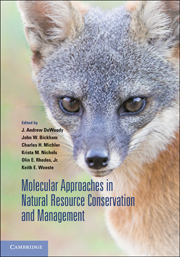Book contents
- Frontmatter
- Contents
- Contributors
- Preface
- 1 Biodiversity discovery and its importance to conservation
- 2 Gene flow, biodiversity, and genetically modified crops: Weedy rice in Thailand
- 3 A community and ecosystem genetics approach to conservation biology and management
- 4 Vertebrate sex-determining genes and their potential utility in conservation, with particular emphasis on fishes
- 5 Historical and contemporary dynamics of adaptive differentiation in European oaks
- 6 Association genetics, population genomics, and conservation: Revealing the genes underlying adaptation in natural populations of plants and animals
- 7 Hybridization in threatened and endangered animal taxa: Implications for conservation and management of biodiversity
- 8 Pollen and seed movement in disturbed tropical landscapes
- 9 Implications of landscape alteration for the conservation of genetic diversity of endangered species
- 10 Integrating evolutionary considerations into recovery planning for Pacific salmon
- 11 Using molecular methods to improve the genetic management of captive breeding programs for threatened species
- 12 Wildlife reintroductions: The conceptual development and application of theory
- 13 Evolutionary toxicology
- Index
- Plates
- References
5 - Historical and contemporary dynamics of adaptive differentiation in European oaks
Published online by Cambridge University Press: 05 July 2014
- Frontmatter
- Contents
- Contributors
- Preface
- 1 Biodiversity discovery and its importance to conservation
- 2 Gene flow, biodiversity, and genetically modified crops: Weedy rice in Thailand
- 3 A community and ecosystem genetics approach to conservation biology and management
- 4 Vertebrate sex-determining genes and their potential utility in conservation, with particular emphasis on fishes
- 5 Historical and contemporary dynamics of adaptive differentiation in European oaks
- 6 Association genetics, population genomics, and conservation: Revealing the genes underlying adaptation in natural populations of plants and animals
- 7 Hybridization in threatened and endangered animal taxa: Implications for conservation and management of biodiversity
- 8 Pollen and seed movement in disturbed tropical landscapes
- 9 Implications of landscape alteration for the conservation of genetic diversity of endangered species
- 10 Integrating evolutionary considerations into recovery planning for Pacific salmon
- 11 Using molecular methods to improve the genetic management of captive breeding programs for threatened species
- 12 Wildlife reintroductions: The conceptual development and application of theory
- 13 Evolutionary toxicology
- Index
- Plates
- References
Summary
INTRODUCTION
There is growing interest in estimating rates of evolutionary change, motivated by the ongoing environmental change (Gingerich 2001; Stockwell et al. 2003; Carroll et al. 2007). Particular concerns have been raised about forest trees, which are thought to be less able to adapt to these rapid changes due to their long generation time (Reich & Oleksyn 2008). Other authors have suggested that large standing genetic variation in trees may enable rapid adaptive responses, at a pace matching that of ongoing climate change (Kremer 2007; Aitken et al. 2008). An elegant approach to get some insights on the evolutionary responses to global warming is to reconstruct past genetic changes and processes that occurred during the postglacial periods, when temperatures were steadily increasing (Petit et al. 2008). The timing and direction of spread of wind-pollinated trees following the last ice age can be reconstructed from their pollen remains in sediments (e.g., Cheddadi et al. 2005). Palynological data have now been compared to phylogeographic approaches based on range-wide surveys of genetic fingerprints of maternally inherited organelle genomes (Petit et al. 2002b for oaks, Magri et al. 2006 for beech, Cheddadi et al. 2006 for Scots pine). This combination has elucidated genetic and demographic processes associated with tree responses to environmental change. A second approach for predicting adaptive responses to environmental changes is based on theory and simulations (Bürger & Lynch 1995; Bürger & Krall 2004; Sato & Waxman 2008). These studies have been limited so far to single populations and have focused on the amount of environmental change that a population can tolerate, given its genetic and demographic properties.
- Type
- Chapter
- Information
- Publisher: Cambridge University PressPrint publication year: 2010
References
- 24
- Cited by



